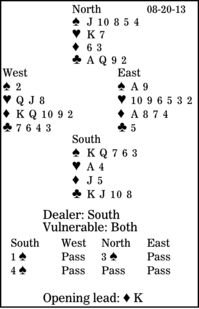Bridge column, August 20: Take control when you see the solution

At the bridge table, though, who controls the present often controls the future. In this deal, how should the defense go against four spades after West leads the diamond king?
North, a point-count addict, made a three-spade, game-invitational limit raise with a hand that is worth a game-forcing raise. Apply the Losing Trick Count. The North hand has only six losers: two spades (because you deduct one loser for a 10-card or better fit), one heart, two diamonds and one club. A limit raise shows eight losers; a game-forcing raise promises seven or fewer.
East wondered about intervening with four hearts, but knew that it was highly dangerous. However, note that five hearts goes down only one, which is very cheap if four spades is making. Those double fits are delicious.
At trick one, East should pause for thought. From where might four defensive tricks come? He can see the spade ace and presumably two diamonds, but what is number four?
Right -- a club ruff in the East hand. However, if East plays a discouraging diamond four at trick one, West will probably shift to the heart queen. East must take control. He overtakes the diamond king with his ace and switches to his singleton club.
East wins the next trick with his spade ace and returns the diamond four. West takes that and gives his partner the lethal ruff.
If you can see how to defeat the contract, grab the steering wheel.
** ** **
COPYRIGHT: 2013, UNITED FEATURE SYNDICATE
DISTRIBUTED BY UNIVERSAL UCLICK FOR UFS

